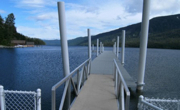 Carson Tak has made history as the first known modern-era sail-powered passenger service captain/entrepreneur. In his home waters of British Columbia's Georgia Strait in the Salish Sea, Carson provides travelers an alternative to the subsidized ferry that some call The Noise Boat. Besides noiselessy harnessing the wind as much as possible, his sloop Windswept beats the ferry service in some cases by offering direct voyages, so that a passenger does not have to take three ferries to make a destination. Additionally, he offers rides to unserved islands and the mainland. 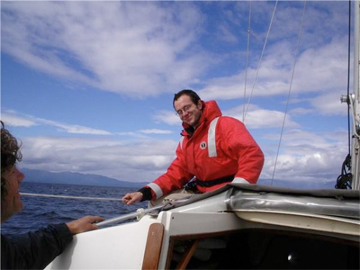 Carson in his floatation jacket/suit
Such a life as Carson Tak's is enviable. However, what he's doing for a living is more than just float and gloat. He raises awareness on the world's oil crisis every time he hoists his sails, and on land as well as sea he participates in sustainable economics: utilizing and promoting the gift economy. Simple living is not so simple, to the uninitiated and unimaginative. Sailing the Salish Sea (the name of his venture) is not something anyone can replicate anywhere -- at least at this point while subsidized oil is still relatively cheap. As such, today the middle-aged, debt-ridden person with a high cost of living would "never" embark on creating a sail-powered transport service. Carson is 21 years old and a life-long sailor, with experience as a school teacher among the Acadians. Somehow he learned to just have to work two days a week in order to pay rent, thanks largely to work-trades. He has few expenses, and avails himself of part-time opportunities such as tutoring a friend's son for pay. Here is Carson's regular run, established in the middle of spring 2010: On his 30-foot Pearson sloop, the Windswept, Carson sails up to six passengers per load between Vancouver Island's French Creek marina and Lasqueti Island's False Bay dock each Tuesday. (That's the day during summer that the regular ferry does not run.) The distance covered is 9 nautical miles, and usually takes two to three hours. The time depends on the wind, although the Windswept has a 9.9 horsepower outboard engine running on gasoline. On other days of the week Carson could be sailing elsewhere (e.g., ferrying folks to and from a music festival). 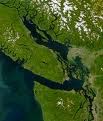 Salish Sea - right lower corner is Puget Sound
Passengers are encouraged to in effect take extra time, if necessary, to rely as much as possible on the wind, so as to use no petroleum. So a customer/crew member of Sailing the Salish Sea can be the decider. On the acquisitions list is a set of 11-foot oars as a non-petroleum auxiliary form of power and means of maneuvering. Although rowing takes up valuable cockpit room, on calm days passengers can be on the foredeck. An example of a special run, by demand only, has been to sail to Hornby Island 15 nautical miles from Lasqueti. Two WOOFERS, or Workers on Organic Farms (a travelers network), took their bicycles on Carson's Windswept in order to avoid having to take three motorized ferry rides to the same place. This is an example of a niche market for an enterprising sailboat captain. Reactions from the public and friends have been extremely positive for Sailing the Salish Sea. "They are my best advertising." Carson relies upon word-of-mouth and the Lasqueti Island website that posts his availability and plans on a message board.
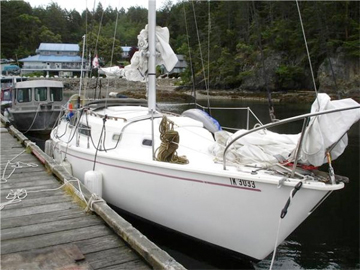 the Windswept
The essence of Carson's passenger service, and of the time-honored, once universal gift economy, is that one can "pay for" the ride or give compensation in a variety of ways. It comes down to the crew's being friends aboard with a common purpose, unlike a commercial operation requiring paperwork and separating captain/owner from the public. Responsibility is shared. Many passengers are repeats, and Some are agile sailors, which helps Carson manage the voyage more easily, for example to make the pancakes in the galley. At other times Carson is happy to teach knots and boat maintenance, and have passengers steer. What it comes down to is this: for passage you can either make a donation or do a work trade separate from the voyage. For example, Carson's garden is large and needs work, so he accepts gardening volunteers. A painter who sailed "for free" is doing a portrait of Carson. The captain is expecting three pies from another passenger. Carson himself does work trade with his landlady (who sews sails) to help cover his modest rent. Culture Change asked Carson: How and why did the sail transport idea come to you? 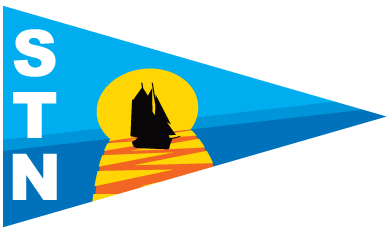 CT: In high school in a geography class we covered alternative energy, such as wind power generators. But I thought the idea of taking the energy first to a lead acid battery, etc. was inefficient. I wondered why we weren't discussing taking the wind directly. I had sailed since I was five years old. I was inspired by Sail Transport Network that I found online, and read Dmitry Orlov's "The New Age of Sail" which impressed me. On the East Coast I read the book Sailing Back in Time, by Maria Coffey and Dag Goering, and learned of Allen Farrel who built traditional sailboats such as the junk China Cloud which had a yulah sculling oar. CC: What voyages for Sailing the Salish Sea that you have made that stand out in your mind the most? 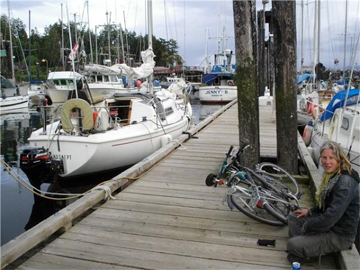 Yolanda with her bike for integrated multimodal transit
CT: I helped a woman move, filling the Windswept to the brim at French Creek, and sailed all the way to Lasqeti without the motor. Another trip involved taking the Lasqueti Marching Band, drum and all, over to Vancouver Island. A few days ago I sailed a friend over to the island of Texada to a part of the island where there's no dock. [The island is 50 km (30 mi.) long with only 1100 residents.] If the weather were choppy he could swim from a point close to the shore. But he got into a kayak that was tethered to the Windswept, and when he got to shore and disembarked I was able to just pull the kayak back and be on my way. CC:
CT: A multi-hull (catamaran or trimaran) could outrun a motor ferry. Carrying people on a multihull has more potential than cargo because of the weight. There's dangerous ship traffic near Vancouver, but a sail passenger service could work. My costs would be higher, but the wealthier people of Vancouver could afford it. And the operation could make BC world renowned for a sail transport service for the islands. Long term, this project is more viable by the day. The French Creek Ferry's actual subsidized cost is $30 per passenger ticket, but the price is $8. If I got $30, I could do much more including pay myself. At this point I'm just covering the boat cost. CC:How might you improve or expand your operation? 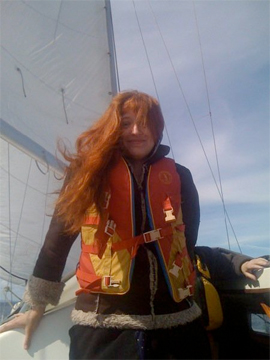
CT: Sailing the Salish Sea is a pilot project, an example of what I and others can do in future here and elsewhere. I could get a grant, a loan, or an investor for expansion. There's potential for Sail Transport Network having other runs. But right now there's a limit to going mainstream in this region due to small population. CC:And your more immediate plans?
CT: CC: CT: CC:I'm sure the conversations on a relaxing, beautiful sailboat ride run the whole gamut.
CT: 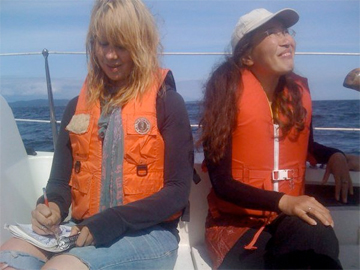 CC: How does Sailing the Salish Sea fit in with the lifestyle and community of Lasqueti?
CT: But I've brought buckets of fish guts from French Creek to fertilize my garden. The fish processing plant there can supply a lot more, so I've been thinking of towing a small barge behind the Windswept. This would be a sustainable soil amendment, an alternative to manure in plastic bags. CC:Just over ten years ago when I was getting ready to try to launch Sail Transport Network, I first thought of not freight but passenger service, and now you're doing it.
CT: * * * * * SailTransportNetwork.com is the new "Drupal system" website separate from culturehange.org.
Contact Sailing the Salish Sea via email: ctak127 "at" hotmail.com. Lasqueti Island website with message board: from Carson Tak:
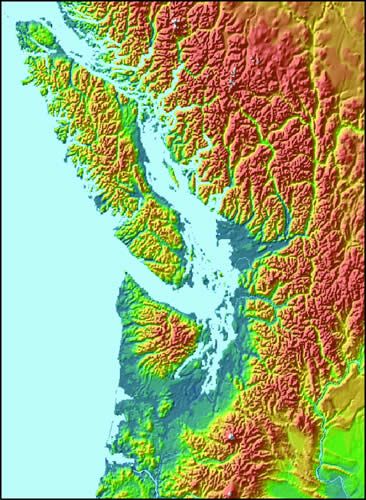 Sailing the Salish Sea Note: the Salish group of Indians or First Nations people was large and diverse throughout the Pacific Northwest and eastward. The inland sea area called the Salish Sea extends from Olympia, Washington through the Puget Sound, past the San Juan Islands to the Georgia Strait, as far north as Canada's Desolation Sound. |
|||
 |
||
|
|
